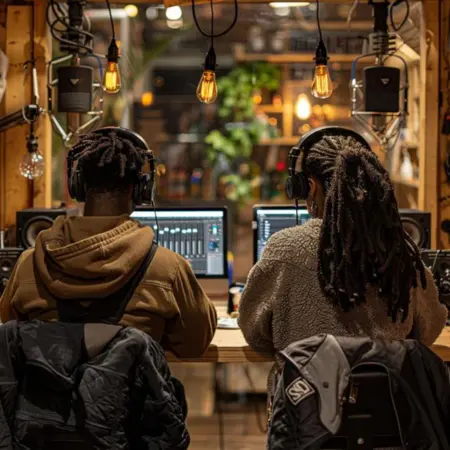Do you want to start a podcast? Awesome! But how do you get rid of the robotic voice and sound natural?
This blog offers amazing tips to transform your podcast voice from rough to fantastic.
Get ready to turn your listeners into conversation friends.
Key Takeaways
– Be yourself: Speak in your own way and focus on getting your message across clearly.
– Silence is okay: Pauses are good! They give listeners time to think and make the conversation flow better.
– Chat, not read: Talk naturally like you’re talking to a friend; be spontaneous.
– Practice makes perfect: Talk about your topic beforehand to feel comfortable recording.
– Editing helps: Editing can make you sound more energetic while keeping it real.
How To Sound Natural On A Podcast: 5 Real Time Tips
Sounding natural is key to attracting an audience in the growing world of podcasts.
When you sound natural, you create an atmosphere of trust. It also enhances the listening experience of your audience.
Natural speech makes your podcast more enjoyable for your listeners.
Listeners can easily figure out a rough delivery. But a natural voice allows them to connect with you more deeply.

Here are some tips to help you master the art of sounding natural in your podcast:
Tip 1. Embrace Yourself
It is a very famous quote by Roy T.Bennett
“To shine your brightest light is to be who you truly are.”
The core of being natural starts with being yourself. Accepting your voice and the way you speak.
Trying to change that won’t win over listeners. Instead, focus on your voice effectively. Speak clearly, with a touch of growth.
Use your natural voice with confidence for the topic, and don’t fear natural changes in the pitch. These changes keep the listeners engaged.
Here are some tips for being yourself and sounding natural:
– Find Your Voice: Before recording, think about what you love and are good at. What makes your perspective different?
– Talk to Your Listeners, Not Over Them: Imagine you’re chatting with a friend, not giving a class. Use clear, easy-to-understand words.
– Be Real, Not Rehearsed: Ditch the scripts and jokes. Your unique voice is what people will like. Talk naturally, like you’re telling a friend about the topic.
– Chill Out and Have Fun: Don’t stress about perfection. Relax, take breaths, and speak at a normal pace. The audience can tell when you’re tense.
So, there’s no need to get nervous. Remind yourself that it’s okay to be imperfect. Trust your abilities. Be present in the moment and have fun.
Tip 2. Welcome The Pause
Remember, silence during communication isn’t your enemy on a podcast. Befriend the pause.
Pausing after an important point lets your idea sink in. It gives listeners a moment to absorb what you’ve said. Your conversation also sounds natural.
It is a natural process, and we don’t speak nonstop daily. So, don’t feel pressured to fill every second with words.
These small pauses stress your point and make your delivery sound real.
Here are some ways to welcome the pauses in your podcast:
– Pause and Breathe: Take short breaks while talking. Take your time filling every silence. This gives your voice space and makes you sound calmer.
– Think First, Speak Clear: Instead of saying “um,” take a moment to organize your thoughts. – This will help you speak slowly and confidently.
– Listen Like a Friend: Listen carefully, respond to their points, and ask questions. This keeps the conversation flowing naturally.
So, next time you record, let the silence work its magic, and you’ll be amazed at how much more natural you sound.
Tip 3. Conversation, Not Script
Conversations, not scripts, are the recipe for sounding natural during podcasts.
Engaging in genuine discussion enhances the natural flow of your podcast.
Imagine that you’re having tea with your friend and not giving a presentation.

Here are some tips to achieve it:
– Be Yourself: People can tell when you’re faking it. Real conversations sound best, so ditch the script and just chat.
– Go with the Flow: A plan is good, but don’t let it stop you from having fun! Talk about what comes up naturally, even if it means changing the topic.
– Expect the Unexpected: Be open to surprises – your guest might say something awesome! These real moments make your podcast special.
Tip 4. Practice Makes Progress
There’s a famous saying by Les Brown.
“Everything we do is practice for something greater than where we currently are. Practice only makes for improvement.’
The more comfortable you are behind the mic, the more natural you’ll sound. Practice talking about your chosen topic. Listen back and identify areas for improvement.
Is your pronunciation clear? Does your pace and volume vary naturally?
Think of it as learning a new skill. The more you rehearse, the more natural your delivery will become.
Your practice sessions are your secret weapon for a polished and engaging podcast. But remember, there’s a difference between practice and over-script.
Here are some key ways to add this practice to your daily routine:
– Mock Cast: Set up your recording space as you normally would. Record yourself talking as if it’s a real episode, but relax – nobody’s listening (yet!).
– Pay attention to how you sound: are your words clear, is your pace good, and are there any weird pauses?
– Listen and Learn From Yourself: listen to the words you use. Do they sound natural, or are they a bit stiff? If something sounds off, make a note to improve it next time.
– Get Feedback From Friends: Don’t be shy about asking for help! Their feedback will help you identify areas for improvement.
Remember, your listeners are your real target. So, embrace the feedback and watch your podcast become a natural conversation.
Tip 5. Editing Is Your Screen Weapon
Great editing is a magical touch for sounding natural during a podcast. It’s like having a behind-the-scenes friend who polishes your natural energy.
It’s not about creating a flawless, robotic conversation.
A skilled editor can create magic in your recording. They’ll remove long pauses and unwanted background noise without disturbing the flow.
They can even make it smoother by linking natural breaths or short pauses. The best part? This editing keeps the conversation real and engaging.

Here’s a step-by-step guide on how to achieve good editing:
– Start with Great Audio: Use good mics and record in a quiet space. Clean up background noise while editing.
– Cut the Extras: Remove unnecessary pauses, “umms,” and “you knows.” A few pauses are fine, but too many break the flow.
– Sound Like a Pro: Use editing tools to adjust the volume and make your voice clear. Get rid of unwanted background sounds.
– Keep it Natural: Don’t edit so much that it sounds fake. A little imperfection makes your podcast real.
– Polish It Up: Listen to your edited podcast like a listener. Make sure it sounds smooth and professional.
How To Hear A Podcast
Podcasts are like radio shows, but you can listen whenever possible. There are millions of podcasts on all sorts of topics.
Here is how to listen to podcasts on your phone, computer, car, and even smart speakers.
1. How To Listen To Podcasts On Android
In the past, listening to podcasts on Android phones wasn’t as easy as on iPhones. There used to be a default app, Google Podcasts, but it’s going away in 2024.
This means Google might focus on YouTube podcasts instead. But not all podcasts are available there yet.
There are other great apps for listening to podcasts on Android, like
– Podcast Addict
– Pocketcasts
– Castbox.
You can also listen to podcasts on Spotify if you already use it for music.
2. How To Hear A Podcast On iPhone
Got an iPhone? You’re in luck! Your phone already has a podcast app called Apple Podcasts. It’s easy to use – you can find shows to listen to and follow them.
Just open the app, pick a show, and hit play!

There are other podcast apps for iPhones, like Overcast and Pocketcasts. However, the Apple Podcasts app is a good starting point.
3. How To Listen To Podcasts In The Car
Want to listen to podcasts in your car? You’re not alone! Cars are a popular podcast spot, like the new radio. Here’s how to get them going:
– Bluetooth: Most cars can connect to your phone via Bluetooth for hands-free calling. Just connect and hit play on your podcast app.
– Cable: No Bluetooth? No problem! Many cars have an aux-in or line-in port resembling a headphone jack. Just use a regular aux cable to connect your phone to your car.
4. How Can I Listen To Podcasts For Free
Listening to podcasts for free is easy! Here are some common methods:
– Apps: Apps like Spotify and Stitcher allow you to find and listen to podcasts. Download the app, search for what you like, and hit play!
– Websites: Some podcast makers have their shows on their websites. You can visit their site to listen to or download episodes directly.
– Online Streaming: Podcasts can be streamed online on sites like SoundCloud. You can listen without downloading anything.
– Libraries: Some libraries offer podcasts through apps like Libby or OverDrive. Check with your local library to see if they have this option.
– YouTube: Many podcasts are available on YouTube. Search for the podcast name or browse channels that upload podcasts.
– Networks: Some podcast networks, like NPR, offer free shows on their websites or apps.
Conclusion
In this blog, we’ve briefly discussed five tips to sound natural on a podcast.
Follow these tips, and your natural voice will shine through. Remember, your podcast is a conversation. Be yourself.
Throw your nerves today, accept your qualities, and start doing a natural podcast.
Your fans will be right there with you, enjoying the ride.
- How To Keep The Conversation Going: 12 Expert Tips That Work - December 26, 2024
- Master Speech And Debate: 5 Essential Tips For Success - December 16, 2024
- 11 Communication Quotes To Inspire & Improve Conversations - November 20, 2024

Leave a Reply